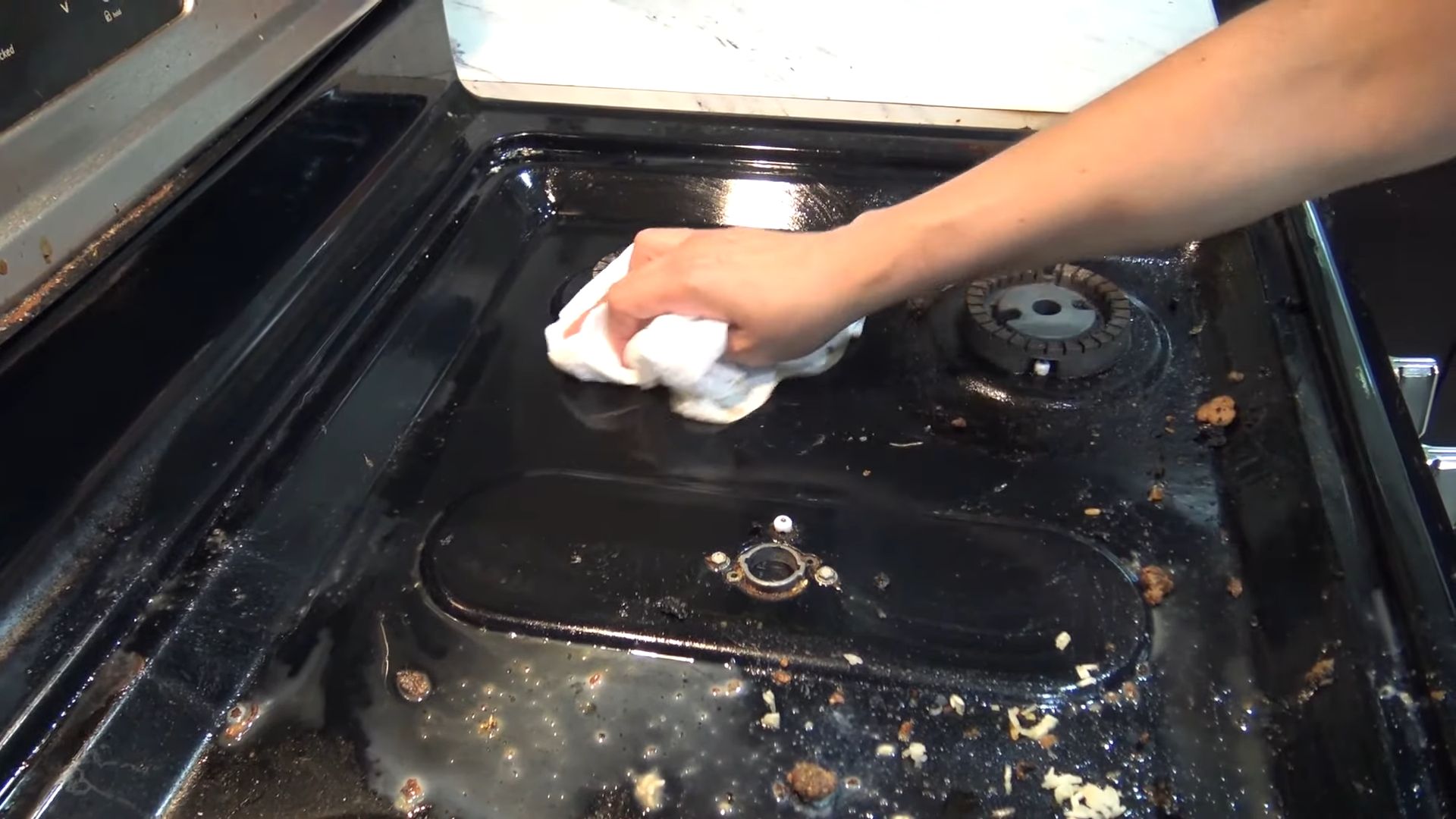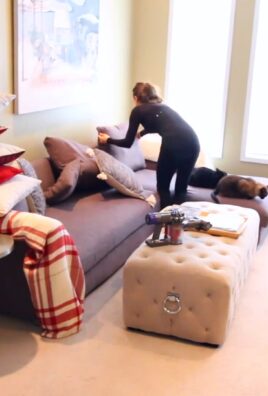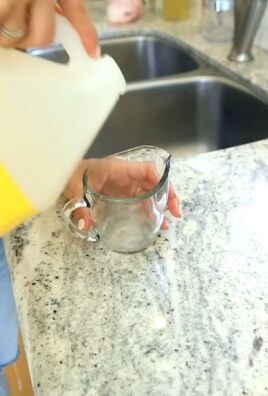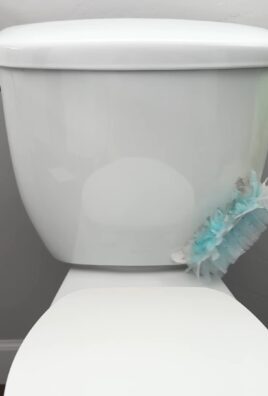Clean Gas Stove: Is your gas stove looking less like a culinary command center and more like a Jackson Pollock painting gone wrong? Don’t despair! We’ve all been there. A sparkling clean gas stove isn’t just about aesthetics; it’s about efficiency, safety, and frankly, a little bit of kitchen pride.
For generations, the heart of the home has revolved around the hearth, and in modern times, that translates to the gas stove. From simmering sauces passed down through family recipes to quickly whipping up a weeknight dinner, our stoves are workhorses. But all that deliciousness can leave behind a sticky, burnt-on mess.
Let’s face it, scrubbing away at stubborn grease and grime isn’t anyone’s idea of a good time. That’s why I’m sharing my favorite DIY tricks and hacks to clean gas stove components quickly and easily. These methods are not only effective but also use ingredients you likely already have in your pantry. Say goodbye to harsh chemicals and hello to a sparkling clean stove, ready for your next culinary adventure! I’ll guide you through simple steps to restore your stove to its former glory, making cooking a joy again.

DIY Deep Clean: Revive Your Grimy Gas Stove Like a Pro!
Okay, let’s face it, gas stoves are amazing for cooking, but keeping them clean? Not so amazing. Food splatters, grease build-up, burnt-on messes – it’s a constant battle! But don’t worry, I’m here to walk you through a deep clean that will leave your gas stove sparkling like new. This isn’t just a quick wipe-down; we’re going to get into all the nooks and crannies. Trust me, the results are worth it!
What You’ll Need: Your Cleaning Arsenal
Before we dive in, let’s gather our supplies. Having everything ready will make the process much smoother. Here’s what I recommend:
* Dish Soap: A good degreasing dish soap is essential.
* Baking Soda: This is our secret weapon for tackling stubborn stains.
* White Vinegar: Vinegar helps cut through grease and grime.
* Spray Bottle: For easy application of cleaning solutions.
* Microfiber Cloths: These are great for wiping surfaces without leaving streaks.
* Non-Scratch Scrub Sponge: For scrubbing without damaging your stove.
* Old Toothbrush: Perfect for cleaning tight spaces and burner caps.
* Paper Towels: For soaking up messes and drying surfaces.
* Safety Gloves: To protect your hands from harsh chemicals (optional, but recommended).
* Small Bowl or Container: For soaking burner caps and grates.
* Needle or Wire: For unclogging burner ports (if needed).
* Soft Cloth or Sponge: For gentle cleaning.
* Optional: Oven cleaner (for extremely stubborn stains, use with caution and follow instructions carefully).
Safety First!
Before we even think about cleaning, let’s make sure we’re being safe.
1. Turn off the gas supply: Locate the gas shut-off valve behind your stove or in your basement and turn it off. This is crucial to prevent any accidents.
2. Ensure the stove is cool: Never clean a hot stove! Wait until it’s completely cool to the touch.
3. Ventilation: Open windows or turn on your kitchen exhaust fan to ensure proper ventilation, especially if you’re using stronger cleaning products.
Disassembling the Stove: Getting Ready to Clean
Now, let’s take the stove apart so we can clean each component thoroughly.
1. Remove the Grates: Carefully lift off the grates. These are usually the dirtiest part, so we’ll give them extra attention.
2. Remove the Burner Caps and Heads: Lift off the burner caps and then the burner heads (also called burner bases). These might be a little stuck, so gently wiggle them until they come loose.
3. Remove Knobs (If Possible): Some knobs can be pulled straight off, while others might require a small screwdriver. Check your stove’s manual if you’re unsure. If they’re difficult to remove, you can clean them in place.
Cleaning the Grates: Tackling the Toughest Messes
The grates usually bear the brunt of the cooking mess, so let’s start here.
1. Soaking the Grates: Fill your sink or a large tub with hot, soapy water. Add a generous amount of dish soap and let the grates soak for at least 30 minutes. For really stubborn messes, you can add 1/2 cup of baking soda to the water.
2. Scrubbing the Grates: After soaking, use your non-scratch scrub sponge to scrub the grates thoroughly. Pay special attention to burnt-on food and grease. If you have extremely stubborn spots, you can make a paste of baking soda and water and apply it directly to the stains. Let it sit for a few minutes before scrubbing.
3. Rinsing and Drying: Rinse the grates thoroughly with clean water to remove all traces of soap and baking soda. Dry them completely with a clean towel or let them air dry.
Cleaning the Burner Caps and Heads: Unclogging and Shining
These parts are crucial for even flame distribution, so keeping them clean is important.
1. Soaking the Burner Caps and Heads: In a small bowl, mix hot water with dish soap and a tablespoon of white vinegar. Soak the burner caps and heads in this solution for at least 30 minutes.
2. Scrubbing the Burner Caps and Heads: Use your old toothbrush to scrub the burner caps and heads, paying close attention to the small holes (ports). These ports can get clogged with food particles and grease, affecting the flame.
3. Unclogging the Burner Ports: If you notice any clogged ports, use a needle or thin wire to gently poke through them and remove any debris. Be careful not to enlarge the holes.
4. Rinsing and Drying: Rinse the burner caps and heads thoroughly with clean water. Make sure all soap and vinegar are removed. Dry them completely before reassembling.
Cleaning the Stove Top: The Main Event
Now, let’s tackle the stove top itself.
1. Wiping Up Loose Debris: Use a damp microfiber cloth to wipe up any loose crumbs, spills, or debris from the stove top.
2. Applying Baking Soda Paste: Make a paste of baking soda and water (about 3 tablespoons of baking soda to 1 tablespoon of water). The consistency should be thick enough to spread easily. Apply the paste to any areas with burnt-on food or grease stains.
3. Letting the Paste Sit: Let the baking soda paste sit for at least 15-20 minutes. This will help loosen the stubborn stains. For really tough stains, you can let it sit for longer, even overnight.
4. Scrubbing the Stove Top: Use your non-scratch scrub sponge to scrub the stove top, focusing on the areas where you applied the baking soda paste. Apply gentle pressure and scrub in a circular motion.
5. Wiping with Vinegar: Fill your spray bottle with white vinegar. Spray the entire stove top with vinegar. The vinegar will react with the baking soda, creating a fizzing action that helps lift away the remaining grime.
6. Wiping Clean: Use a clean, damp microfiber cloth to wipe away the baking soda and vinegar mixture. Rinse the cloth frequently to remove all residue.
7. Drying the Stove Top: Use a clean, dry microfiber cloth to dry the stove top thoroughly. This will prevent water spots and leave it looking shiny.
Cleaning the Control Knobs: A Little Extra Shine
Don’t forget the control knobs!
1. Cleaning in Place (If Not Removed): If you couldn’t remove the knobs, use a damp cloth with a little dish soap to wipe them clean. Use a cotton swab to get into any crevices. Rinse with a clean, damp cloth and dry thoroughly.
2. Cleaning Removed Knobs: If you removed the knobs, soak them in warm, soapy water for a few minutes. Then, scrub them with a soft brush or cloth. Rinse with clean water and dry thoroughly.
Reassembling the Stove: The Grand Finale
Now that everything is clean and dry, it’s time to put the stove back together.
1. Replace the Burner Heads: Make sure the burner heads are properly aligned with the gas supply tubes. They should sit securely in place.
2. Replace the Burner Caps: Place the burner caps on top of the burner heads.
3. Replace the Grates: Carefully place the grates back on the stove top. Make sure they are properly aligned and stable.
4. Replace the Knobs: If you removed the knobs, push them back onto their posts.
Testing the Burners: Ensuring Everything Works
Before you start cooking, let’s make sure everything is working properly.
1. Turn on the Gas Supply: Turn the gas shut-off valve back on.
2. Test Each Burner: Turn on each burner individually to make sure it ignites properly and the flame is even and blue. If the flame is yellow or orange, it could indicate a problem with the gas supply or burner. Consult a professional if you have any concerns.
Dealing with Extremely Stubborn Stains (Optional): The Oven Cleaner Option
If you have extremely stubborn stains that won’t come off with baking soda and vinegar, you can try using oven cleaner. However, use this as a last resort and follow the instructions carefully.
1. Protect Your Surroundings: Cover the surrounding countertops and floor with newspaper or plastic sheeting to protect them from overspray.
2. Apply Oven Cleaner: Spray the oven cleaner directly onto the stubborn stains. Be sure to wear gloves and eye protection.
3. Let it Sit: Let the oven cleaner sit for the recommended time (usually 15-3

Conclusion
So, there you have it! Mastering the art of cleaning your gas stove doesn’t require expensive cleaners or hours of scrubbing. This simple, effective DIY trick, using readily available household ingredients, is a game-changer for anyone who wants a sparkling clean kitchen without the harsh chemicals. We’ve shown you how to banish grease, grime, and burnt-on food with minimal effort, leaving your gas stove looking brand new.
Why is this DIY method a must-try? Because it’s not just about aesthetics; it’s about creating a healthier and safer cooking environment. A clean gas stove burns more efficiently, saving you energy and money. It also reduces the risk of flare-ups and unpleasant odors. Plus, you’re avoiding the potentially harmful fumes and residues left behind by many commercial cleaners.
But the best part? This method is incredibly versatile. Feel free to experiment with variations to suit your specific needs and preferences. For instance, if you have particularly stubborn stains, try letting the baking soda paste sit for a longer period, even overnight. You could also add a few drops of essential oils, like lemon or tea tree, to the cleaning solution for an extra boost of freshness and antibacterial properties. For stainless steel surfaces, be sure to wipe in the direction of the grain to avoid scratches. Remember to always test any cleaning solution on a small, inconspicuous area first to ensure it doesn’t damage the surface.
Don’t be afraid to get creative! Some people swear by using a mixture of vinegar and baking soda for an extra-powerful cleaning action. Others prefer to use a soft toothbrush or cotton swabs to reach those hard-to-get-to areas around the burners. The key is to find what works best for you and your gas stove.
We’re confident that once you try this DIY cleaning trick, you’ll be amazed by the results. It’s a simple, cost-effective, and environmentally friendly way to keep your gas stove looking its best.
Now, it’s your turn! We encourage you to give this DIY method a try and see the difference for yourself. And most importantly, we want to hear about your experience. Share your tips, tricks, and before-and-after photos in the comments below. Let’s build a community of clean gas stove enthusiasts and help each other keep our kitchens sparkling! We are eager to hear how this method works for you and any modifications you might have made to improve the process. Your feedback is invaluable and will help us refine and improve this guide for future readers. So, grab your baking soda, vinegar, and a little elbow grease, and get ready to transform your gas stove! Let us know how this method helped you clean gas stove effectively.
FAQ
Frequently Asked Questions About Cleaning Your Gas Stove
Q: How often should I clean my gas stove?
A: The frequency of cleaning depends on how often you cook and how messy you are. As a general rule, you should wipe down your gas stove after each use to prevent spills and splatters from hardening. A more thorough cleaning, using the DIY method described above, should be done at least once a week, or more often if needed. If you notice a buildup of grease or grime, it’s time for a deep clean. Regular cleaning will prevent stubborn stains and make future cleanings easier.
Q: What if I have a gas stove with sealed burners? Does this method still work?
A: Yes, this DIY cleaning method is safe and effective for gas stoves with sealed burners. The key is to avoid getting excessive moisture inside the burner area. When cleaning around the burners, use a damp cloth or sponge instead of soaking them directly. If any water does get inside, allow the burners to air dry completely before using the stove. You can also use a hairdryer on a low setting to speed up the drying process.
Q: Can I use this method on other kitchen appliances, like my oven or microwave?
A: While the basic principles of this DIY cleaning method can be applied to other kitchen appliances, it’s important to consider the specific materials and surfaces involved. For ovens, a similar baking soda paste can be used to clean the interior, but you may need to use a stronger degreaser for stubborn baked-on food. For microwaves, a simple solution of vinegar and water can be used to steam clean the interior. Always consult the manufacturer’s instructions before cleaning any appliance.
Q: What if I don’t have baking soda or vinegar? Are there any alternatives?
A: While baking soda and vinegar are the most common and effective ingredients for this DIY cleaning method, there are some alternatives you can use. For baking soda, you can try using cream of tartar or even a mild dish soap. For vinegar, you can substitute lemon juice or a diluted solution of citric acid. However, keep in mind that these alternatives may not be as effective as baking soda and vinegar, especially for stubborn stains.
Q: How do I prevent my gas stove from getting so dirty in the first place?
A: Prevention is key to keeping your gas stove clean and minimizing the need for deep cleanings. Here are a few tips:
* Wipe up spills and splatters immediately.
* Use splatter screens when frying or cooking with sauces.
* Clean your burners regularly to prevent buildup.
* Avoid overfilling pots and pans.
* Consider using a gas stove burner cover to protect the surface.
Q: Is it safe to use steel wool to clean my gas stove grates?
A: While steel wool can be effective for removing stubborn grime, it’s generally not recommended for cleaning gas stove grates, especially if they are coated with porcelain or enamel. Steel wool can scratch and damage the surface, leading to rust and further buildup. Instead, opt for a non-abrasive scrubbing pad or brush, or soak the grates in hot, soapy water to loosen the grime before scrubbing.
Q: My gas stove has a lot of burnt-on food. How can I remove it without scratching the surface?
A: For stubborn burnt-on food, try making a paste of baking soda and water and applying it to the affected area. Let it sit for several hours, or even overnight, to soften the residue. Then, gently scrub with a non-abrasive sponge or cloth. You can also try using a plastic scraper to carefully lift the burnt-on food without scratching the surface. Avoid using metal utensils or abrasive cleaners, as they can damage the finish.
Q: Can I put my gas stove grates in the dishwasher?
A: Whether or not you can put your gas stove grates in the dishwasher depends on the material they are made of. Some grates, especially those made of cast iron, are not dishwasher safe and can rust or become damaged. Other grates, such as those made of porcelain-coated steel, may be dishwasher safe, but it’s always best to check the manufacturer’s instructions first. If you’re unsure, it’s safer to hand wash the grates with hot, soapy water.
Q: What’s the best way to clean the gas stove burner caps?
A: Gas stove burner caps can accumulate grease and grime over time, affecting the efficiency of your stove. To clean them, remove the burner caps and soak them in a solution of hot, soapy water for at least 30 minutes. Then, scrub them with a non-abrasive brush or sponge to remove any remaining residue. Rinse thoroughly and allow them to dry completely before replacing them on the stove. Make sure the burner ports are clear of any debris to ensure proper gas flow. A small wire or needle can be used to gently clear any blockages.





Leave a Comment